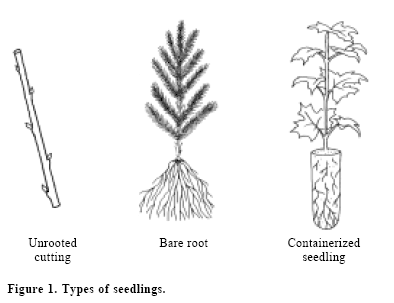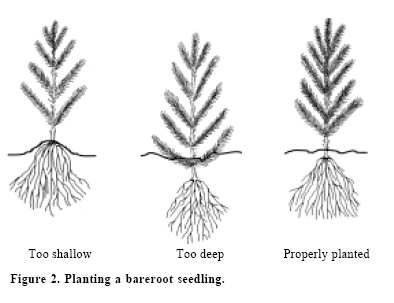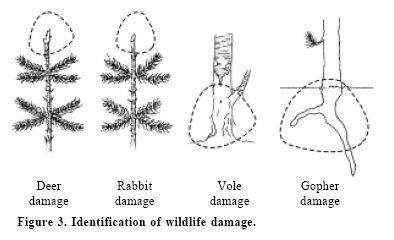G1558
Installing Your Riparian Buffer:
Tree and Grass Planting, Postplanting Care and Maintenance
This NebGuide describes tree and grass planting for riparian buffers, postplanting care of trees and grasses and long-term buffer maintenance. A companion NebGuide, Planning Your Riparian Buffer: Design and Plant Selection (G1557), addresses buffer design and selection of appropriate tree and grass species.
Tom Franti, Extension Surface Water Management Specialist, Scott Josiah, Nebraska State Forester
Mike Kucera, State Resource Conservationist for the Natural Resources Conservation Service
- Installing Your Riparian Buffer
- Postplanting Care of Your Riparian Buffer
- Postplanting Care of Trees and Shrubs
- Minimizing Wildlife Damage
- Postplanting Care of Grasses
- Long-Term Buffer Maintenance
- Resources
- References
- Funding
Riparian buffers are a best management practice to protect stream water quality, reduce streambank erosion, and provide wildlife habitat. Buffers also can provide income through payments from federal, state and local cost-share programs or through production and sale of specialty crops. This NebGuide provides instructions on riparian buffer installation and maintenance for farmers and landowners. It compliments the instructional video, Streamside Conservation: Installing and Maintaining Your Riparian Buffer, available from University of Nebraska Extension. (To order the video, contact the University of Nebraska CIT, P.O. Box 830918, Lincoln, NE 68583-0918, or call 800-755-7765.)
Installing Your Riparian Buffer
Installing Trees and Shrubs
Preparing the Site. Adequate site preparation and proper planting of seedlings and seeds is required for successful establishment of trees and shrubs. Prepare the site for optimal tree growth by removing weeds and past vegetation with burn-down herbicides and/or tilling just prior to the tree or shrub planting. If the site is a grass pasture or an alfalfa field, the vegetation should be killed in the fall prior to spring planting. If desirable native grasses are present, they can be maintained between the tree rows.
Planting Seeds. Tree seeds can be planted by hand or machine. When hand seeding, place the seeds no deeper than two to three times the diameter of the seed. For example, a one-inch diameter black walnut seed should be planted two to three inches deep. Broadcast seeds by hand or machine evenly over the planting area and cover the seeds with soil using a disk or other implement. After seeds are covered, the soil should be packed to ensure good seed to soil contact.
Specialized tree-seeding machines can plant either individual species or a mixture of species for a more random distribution. When machine seeding, plant in a shallow furrow or spread seeds out and disk them into the soil. For more information, refer to University of Nebraska Extension NebGuide G1512, Establishing Conservation Plantings of Nut Trees and Shrubs by Direct Seeding Methods.
Planting Seedlings. Tree seedlings should be planted in April or May. Seedling spacing, both in row and between rows, varies with the expected mature size of the trees or shrubs being planted. NRCS recommended planting densities are shown in Table I (refer to NRCS Conservation Practice Standard Riparian Forest Buffer Code 391 for more detailed information). Seedlings come in several forms which require different planting techniques (Figure 1).
| Table I. NRCS recommended initial tree and shrub planting densities.1 | |||||
| Approximate 20-year Height (feet) |
Plant-to-plant Spacings (feet) |
Row-to-row Spacings (feet) |
Minimum Plants per Acre |
Maximum Plants per Acre |
|
| Small shrubs | less than 10 | 3-6 | 3-6 | 1210 | 4840 |
| Large shrubs and small trees | 10-20 | 6-10 | 6-10 | 440 | 1210 |
| Large trees | greater than 20 | 10-15 | 10-15 | 200 | 440 |
| 1Adapted from NRCS Conservation Practice Standard Riparian Forest Buffer Code 391. Initial planting densities are much greater than mature tree densities. | |||||
 |
 |
 |
With bareroot seedlings, it is important to keep the roots moist and protected before planting. One method is to store them in a mulch-filled plastic container or bag in a cool, dry place. Before planting, bare roots should be temporarily submerged (one to two hours) in a bucket of water to stay moist until they can be placed in the ground. To plant, make a hole large enough to insert the root system without crowding or bending. Turned up roots may kill the plant. Cover roots completely with soil so that the soil surface is at the same level on the stem as it was in the nursery. If this isn’t obvious, plant the first set of lateral roots no deeper than one inch below the soil surface (Figure 2). Pack soil firmly and tamp to remove air pockets.
Planting containerized seedlings is similar to planting bareroot seedlings. Unrooted cuttings need to be placed in the ground with only two to three buds remaining above ground. Avoid planting seedlings in extremely dry, hot or windy conditions. Heat and wind can quickly dry out leaves and roots. Water the soil around the seedlings immediately after planting.
For more detailed information on planting tree and shrub seeds and seedlings, including site preparation and management, refer to Tree/Shrub Planting Procedures, NRCS Nebraska Technical Guide Notice 535 Section IV.
Installing Grasses
Preparing the Site. It is essential to manage weeds and erosion before, during and after planting grasses. In general, weeds are controlled with chemicals, mowing, or hand picking. An effective approach is to plant Roundup Ready® soybeans the year before the grass buffer is installed. Although soybeans don’t provide as much residue as corn, grass can be easily planted into the residue. Weed control can be improved by using a glyphosate herbicide the year before grass planting.
Seeding. For a CCRP buffer grass seeds must be planted at a rate of 40 pure live seeds (PLS) per square foot by broadcasting or drilling. Broadcasting involves spreading seeds on the ground and then incorporating them with light tillage. Mechanical drilling involves inserting the seed directly in the ground at a uniform depth. Drilling provides more accurate seed placement and is the preferred method.
One common reason for grass establishment failure is placing the seed too deep in the ground. A drill can ensure that the seeds are placed only 1/4- to 1/2-inch deep. The mechanical drill does three things: 1) cuts and handles the residue, leaving some on the ground during planting for erosion control; 2) inserts the seed 1/4- to 1/2-inch deep; and 3) covers the seed to ensure good seed-soil contact.
Seed sizes and weights vary; therefore, application rates vary. Grass drills can be calibrated to meter different types of seeds and seeding rates. For example, a common warm season mixture consists of Indiangrass, big bluestem, and switchgrass. Indiangrass and big bluestem are fluffy seeds and switchgrass is a small smooth seed. If you want to plant these seeds, it can be done correctly with a drill. Indiangrass and big bluestem fluffy seeds need to be metered by a finger-type mechanism. The switchgrass smooth seeds need to be metered by a fluted-type mechanism. Calibrate the drill for each type of seed before use to ensure that the metering mechanisms are releasing the right amount of seed. In some areas, drills may be rented from your local Pheasants Forever chapter or your Natural Resources District (NRD).
Postplanting Care of Your Riparian Buffer
You can ensure a productive and functioning buffer by providing care for one to two years after planting. Postplanting care includes controlling and removing emerging weeds, providing plants with adequate water and controlling excessive wildlife damage.
Postplanting Care of Trees and Shrubs
Weed Control. Although weeds were destroyed before planting, they will reappear and compete with the plants for water and nutrients and need to be controlled. Weeds growing between tree rows can be left to protect small trees from hot desiccating winds and to provide wildlife habitat, but care needs to be taken to ensure that weeds, and grasses, don’t excessively compete with young trees. If grass is planted between tree rows, remove weeds to ensure that the grass can get established (see the following section on grasses).
Weed control is most critical in a three- to four-foot radius around a tree or shrub seedling because this is where the roots will be growing. Control weeds with herbicides, mowing or by using a conservation mulch. When using herbicides near tree and shrub areas, make sure the chemical will destroy only the desired weed species and not your trees and shrubs, and be aware of label restrictions for use of these chemicals near bodies of water. Read labels carefully and check with the Nebraska Department of Agriculture if you are unsure of use or label requirements. After trees and shrubs are established, weeds need to be removed as necessary. For more information, refer to the University of Nebraska Cooperative Extension NebFacts, Chemical Weed Control in Tree Planting Projects Part I — Pre-emergence Herbicides (NF362) or Chemical Weed Control in Tree Planting Projects Part II — Postemergence Herbicides (NF363).
Mulches are an excellent means to reduce weed competition and conserve soil moisture. Straw or grass may attract voles (which may feed on tree and shrub seedlings) and are not recommended for use as mulch. Wood chip mulch should surround the plant at a three- to four-foot radius to a depth of four inches to adequately retain moisture and reduce weed growth. Keep the mulch two to three inches away from tree and shrub stems to prevent stem decay and pest problems. Black fabric mulch also can be used to reduce weed growth. It is available in 4-by-4 foot squares or in 6-by-300 foot rolls. Fabric or woodchips can be placed by hand or mechanically, if equipment is available.
Watering. Water newly planted trees one or two times per week, depending on rainfall. If no rain occurs, apply two to five gallons of water per plant per watering, depending on plant size. Providing water during dry periods for the first year or two is as important as site preparation and weed control. If you plant in a dry year, provide water throughout the growing season. If it doesn’t rain for several weeks and the soil is dry two to three inches below the ground, provide water, but if the soil is moist two to three inches down, water later.
Generally, deep less frequent watering is better than shallow frequent watering. Water is commonly supplied manually from a water tank on the back of a truck or trailer. A five-gallon bucket with a small hole in the side also can be used to water seedlings. Fill the bucket with water and set it next to a seedling. The bucket will slowly release water into the soil and can keep the seedling moist for several weeks, depending on the weather.
Minimizing Wildlife Damage
Wildlife can cause significant damage to trees and shrubs in riparian forest buffers during the establishment phase. Knowing what type of damage has occurred will help you select appropriate prevention and control measures. Different animals cause different types of damage (Figure 3). Deer, cottontail rabbits, voles (field mice) and pocket gophers are some of the most common species that damage trees in Nebraska. Deer browse branches and leave a jagged uneven cut. Rabbits may chew branches (leaving sharp tooth marks) or cut them off at a smooth sharp angle. Voles chew bark, leaving small tooth marks. Pocket gophers work underground to girdle and cut off trees.
An integrated pest management (IPM) approach is recommended for controlling wildlife damage in buffers. Use a variety of techniques in a timely manner to reduce loss of trees and shrubs. Techniques include: 1) habitat modification, 2) exclusion, 3) repellents and 4) population management.
Habitat modification involves managing vegetation with herbicides, mulching or mowing to minimize wildlife habitat and thus populations in the buffer. Exclusion includes protecting individual trees or an entire buffer from animal feeding. Individual trees can be protected with plastic or woven-wire tree cylinders or shelters. Perimeter fencing, like polytape electronic fencing, can help protect an entire buffer from deer. Various forms of repellents also can be sprayed on trees to keep wildlife away. Success with repellents varies with location and species, so trial and error may be needed for control of specific pests. Finally, population management involves controlling wildlife through hunting, trapping, or other lethal means.
Postplanting Care of Grasses
Weed Control. The primary postplanting concern in grass planting is weed control. Use mowing or herbicides to control weeds. If weed pressure is high, mowing or shredding may help, but to protect wildlife, grasses should remain at least six inches tall after mowing. Use the proper herbicide for the weed species you are trying to control, and note that warm season grasses require different herbicides than cool season grasses. Check herbicide label restrictions for use near water and other plants.
It may take native grass species two to three years to get well established. First-year plantings may look like a failure, but do not panic. Patience is needed for establishing a native grass buffer.
Long-Term Buffer Maintenance
While postplanting care is essential in getting a buffer established, long-term maintenance is also necessary. Longterm maintenance may include replanting damaged or dead shrubs, trees or grasses, controlling weeds (described previously), harvesting, watering, protecting the buffer from damage by livestock and wildlife, repairing eroded areas, and removing sediment deposited in the buffer.
Replanting. Occasionally, trees or grasses may have to be replanted in a buffer. Wildlife damage or sediment deposition from erosion can kill trees, shrubs, or grasses. Vegetation can be replanted as desired or as required by government program regulations.
Harvesting and Pruning. Periodic harvesting of stems from shrubs and pruning tree branches as well as mowing grasses, can stimulate vigorous growth. Prune trees to remove dead, dying and broken branches. If needed, thin trees prior to maturity to prevent overcrowding and reduced growth.
Watering. It may be necessary to provide water for high-value trees and shrubs during dry periods or droughts to promote vigorous growth. Well-established trees and shrubs rarely need watering, except during severe droughts.
Protection from Livestock. Livestock can trample and damage vegetation (stems and roots) and should be kept out of buffers as much as possible, especially during establishment. Fencing may be needed to protect high-value plantings. Grazing is usually not allowed in CCRP buffers.
Protection from Insects and Disease. Specialty crops, especially fruit and nut-bearing trees, should be examined routinely to detect and treat insect and disease damage. Contact a local Cooperative Extension or NRCS office or plant nursery for help with diagnoses and control options.
Repairing Eroded Areas. Inspect buffers annually and after severe rainfall events for signs of erosion. Areas where grass is missing and where small channels or gullies have started to form should be repaired as soon as possible. Fill with additional soil, regrade the surface and replant grass as soon as possible.
Removing Sediment. Buffers are designed to trap eroded soil, or sediment, that is carried in the runoff water from crop fields. Over time, or after large rainfalls, this sediment can build up in the buffer and bury vegetation. Buffers should be checked for sediment build-up annually and after severe rainfall events. When sediment forms a ridge that blocks water from flowing into the buffer or concentrates water flow through the buffer, the sediment should be removed or spread back on the field. If sediment completely covers vegetation, grasses may need to be replanted after sediment removal or spreading. Excessive soil movement from adjacent fields is a good indicator that additional erosion control measures such as no-till, conservation till or terraces need to be used.
For more detailed information on buffer maintenance and protection from livestock and wildlife, refer to NRCS Nebraska Technical Guide Notice 535 Section IV Tree/Shrub Planting Procedures.
Resources
For more information on installing and maintaining riparian buffers, contact:
- your local University of Nebraska Extension office or visit the University’s Conservation Buffer Web site at www.conservationbuffers.unl.edu;
- your local Natural Resources Conservation Service office or visit the NRCS Web site, Buffer Strips: Common Sense Conservation at www.nrcs.usda.gov/feature/buffers; or
- the USDA Agroforestry Center or its Riparian Forest Buffers Web site at www.unl.edu/nac/riparian.html.
References
Establishing Conservation Plantings of Nut Trees and Shrubs by Direct Seeding Methods, University of Nebraska Extension NebGuide G1512, 2003.Chemical Weed Control in Tree Planting Projects Part I — Pre-emergence Herbicides, University of Nebraska Extension NebFact NF362, 2003.
Chemical Weed Control in Tree Planting Projects Part II — Post-emergence Herbicides, University of Nebraska Extension NebFact NF363, 2003.
Riparian Forest Buffer, Natural Resources Conservation Service Conservation Practice Standard CODE 391.
Tree/Shrub Planting Procedures, Natural Resources Conservation Service Technical Guide Notice 535 Section IV, (2003).
Funding
Partial funding for this publication was provided by an Education Grant from the Environmental Quality Incentives Program (EQIP) through the U.S. Department of Agriculture Natural Resources Conservation Service.
This publication has been peer reviewed.
Visit the University of Nebraska–Lincoln Extension Publications Web site for more publications.
Index: Water Resources Management
Water Qualityl
Issued February 2005